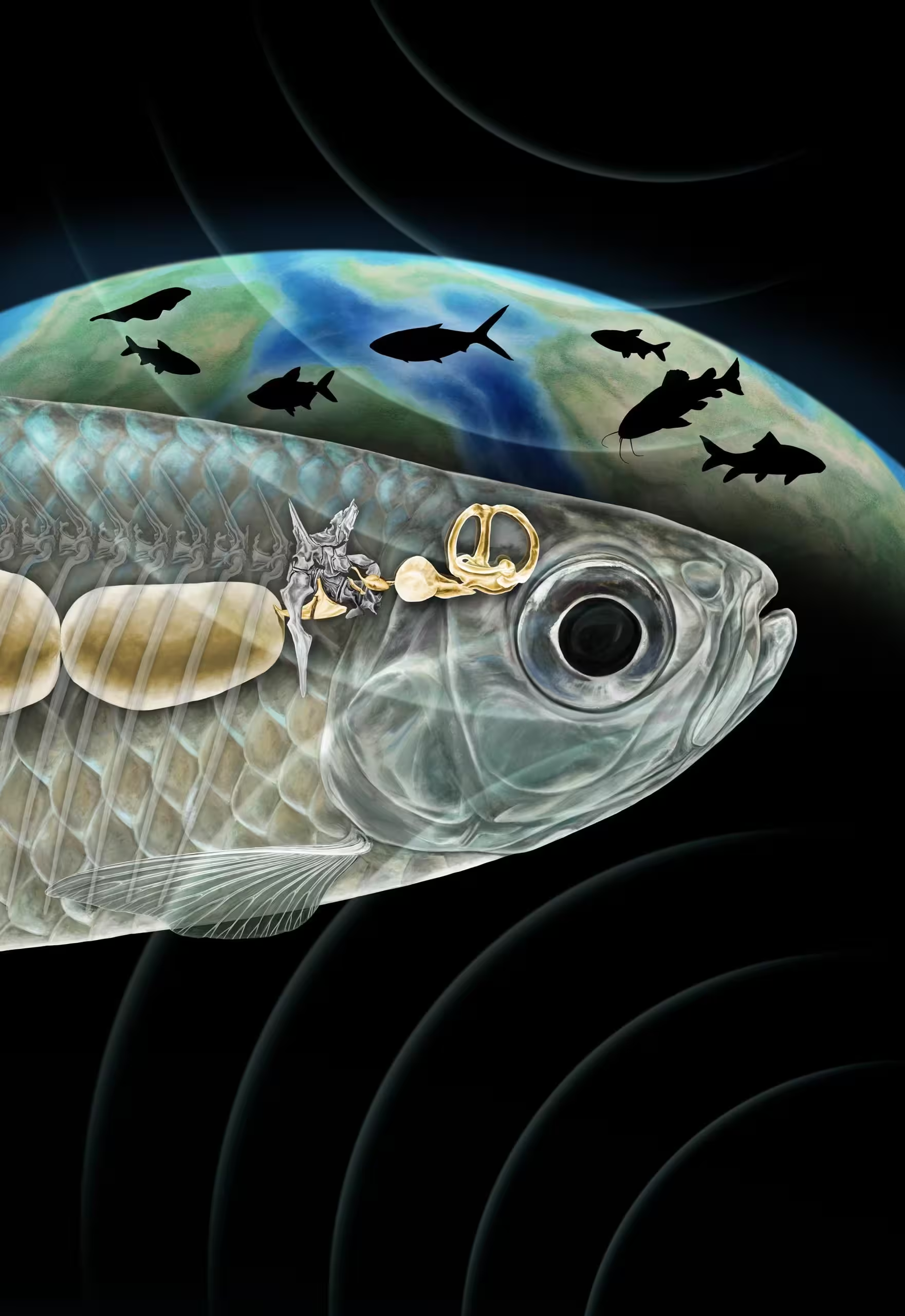10 Minutes
A newly described fossil has upended long-held ideas about how freshwater fish evolved sensitive hearing. By combining fossil CT scans, genomic data and vibration simulations, researchers show that a distinctive middle-ear system — the Weberian apparatus — originated in marine ancestors and became fully functional only after several separate moves into freshwater. The finding reshapes our view of fish evolution and helps explain why two-thirds of modern freshwater species hear so well.

An artist’s reconstruction of the Weberian apparatus in a 67 million-year-old fossil fish. The Weberian structure (gold-colored bones at center) arose from a rib (shown in gray attached to several back bones in the spine) and connect the fish’s air bladder (left) with the inner ear (right). The bony structure endows the fish with more sensitive hearing and is still present today in two-thirds of all freshwater fish species. The background depicts the various fish lineages that evolved after the supercontinent Pangea broke up. Credit: Ken Naganawa for UC Berkeley
New fossil, new timeline: marine roots for freshwater hearing
For decades, scientists believed that the highly successful otophysan fishes — the group that includes catfish, carps, tetras and minnows — first invaded freshwater about 180 million years ago, when the supercontinent Pangea was intact. The conventional story held that a single freshwater origin, followed by continental breakup, explained the modern distribution and diversity of these fish.
That narrative is changing. Paleontologist Juan Liu (UC Berkeley) and colleagues have redescribed a 67-million-year-old fossil, named Acronichthys maccagnoi, and used three lines of evidence to revise the evolutionary timeline. High-resolution CT scans revealed a Weberian apparatus preserved in exquisite detail; genomic comparisons placed otophysan ancestors in marine habitats; and finite-element vibration modeling tested how the fossil ossicles would have transmitted sound. Together, the data indicate that otophysans evolved the rudiments of their hearing system in marine environments and later made at least two independent moves into freshwater where the Weberian apparatus became fully functional.
What is the Weberian apparatus — and why does it matter?
The Weberian apparatus is an anatomical chain of small bones (ossicles) that links an air-filled bladder to the inner ear in certain bony fishes. Think of it as a built-in amplifier that boosts underwater sound vibrations and extends the frequency range a fish can detect. Most ocean fish rely on low-frequency cues and limited sensitivity because sound travels differently in water; otophysan fishes, by contrast, can detect much higher frequencies — zebrafish hear up to about 15,000 Hz — giving them hearing closer to that of many terrestrial animals.
In practical terms, this expanded hearing likely helps fish navigate complex freshwater habitats: noisy streams, shallow lakes, dense vegetation and turbulent flows create acoustic environments where higher-frequency signals may be informative for feeding, predator avoidance or communication.
How the Weberian chain works
- Air bladder: a gas-filled structure that vibrates with passing sound.
- Weberian ossicles: a series of modified vertebrae and ribs that transmit and amplify bladder vibrations to the inner ear.
- Inner ear: fluid-filled chambers with sensory hair cells that convert mechanical motion into nerve signals.
This Rube Goldberg–like mechanism converts pressure fluctuations into meaningful signals inside a fish’s skull — a major evolutionary innovation that has accompanied the explosive diversification of freshwater otophysans.
Juan Liu and her student used finite element analysis to create a computer model of the vibrational response of the Weberian ossicles of fish. This simulation shows the amplitude and vibrations of zebrafish ossicles at a frequency of 1,012 Hertz. The large, triangular ossicle is called the tripus and is a modification of the rib and third vertebra to amplify sound vibrations from the air bladder. Credit: Juan Liu & Zehua Zhou, UC Berkeley and UCMP
Fossil evidence: Acronichthys maccagnoi and ancient hearing
The new species Acronichthys maccagnoi comes from late Cretaceous deposits in Alberta, Canada. Excavations led by ichthyologist Michael Newbrey recovered numerous specimens over six field seasons beginning in 2009. Although the fish are small — around 2 inches long — a few individuals preserved the tiny Weberian bones clearly enough for CT imaging and 3D reconstruction.
Technicians at the Canadian Light Source and at McGill produced high-resolution X-ray scans that allowed Liu’s team to build digital models of the ossicles. Those models fed into finite-element simulations that predict how the fossilized bones would vibrate across different frequencies. The results were striking: the 67‑million-year-old Weberian ossicles would have transmitted sound with sensitivity not far below that of modern zebrafish, with a peak response in the hundreds to about a thousand Hertz — substantially above the low-frequency limits of most marine fish.
A 3D model of the head of the newly named 67 million-year-old fossil fish, Acronichthys maccagnoi, based on CT scans. The skull bones are brightly colored while the ribs and backbones of the spine are in gray. The small, bright red bones at the junction between the spine and head are ossicles of the Weberian apparatus. Credit: Juan Liu, UC Museum of Paleontology & Don Brinkman, Royal Tyrrell Museum
Integrating fossils and genomes: multiple freshwater incursions
Fossils alone cannot resolve habitat transitions, and genomes alone cannot reveal ancient anatomy. By integrating both, the team reconstructed a more nuanced scenario: early otophysan relatives likely evolved in marine settings and developed preliminary Weberian elements there. Subsequently, at least two distinct lineages independently invaded freshwater. In those new environments, the Weberian chain was refined and became fully operational, enabling higher-frequency hearing and potentially fast-tracking diversification.
One of these freshwater lineages led to the catfish, gymnotiforms (knife fish), and many tetras native to Africa and South America. The other gave rise to cypriniforms — carps, suckers, minnows and zebrafish — today the largest order of freshwater fish. Repeated habitat transitions combined with a sensory innovation provide a plausible engine for the hyper-diversity of otophysan fishes across river basins worldwide.
Why better hearing could spur biodiversity
When organisms gain a new sensory or functional capability, they can explore ecological niches previously unavailable. For early otophysans, more sensitive hearing may have opened up new foraging strategies, refined predator-prey interactions, improved mate choice through acoustic signals, or helped navigate turbulent freshwater flows. Each of these possibilities can promote reproductive isolation and speciation.
“The picture that emerges is not a single colonization event, but repeated opportunities seized by fish that already had the building blocks of a hearing system,” Liu says. “Once in freshwater, selection pushed those building blocks toward higher performance and diversification followed.”
Technical approach: scans, simulations and comparative genomics
The study’s strength lies in methodological triangulation. High-resolution CT allowed non-destructive visualization of the tiny ossicles. Finite-element analysis — a technique borrowed from engineering — predicted how those bones would vibrate at different frequencies when coupled to an air bladder and inner ear. Finally, comparative genomics and morphological datasets placed the fossil within a revised family tree that favors a marine common ancestor for otophysans.
These techniques illustrate a modern paleontological workflow: fossils provide direct anatomical evidence, digital imaging extracts three-dimensional detail, computational physics tests function, and genomic context situates evolutionary pathways. The result is an integrated narrative that would have been impossible using any single approach alone.
Broader implications and future directions
Re-evaluating when and where key innovations evolved changes how scientists think about macroevolutionary patterns — especially the role of habitat shifts in generating biodiversity. The idea that repeated incursions into a new environment promote rapid species formation could apply to other groups beyond fishes.
Future work will look for older fossils with preserved Weberian structures, expand genomic sampling across obscure otophysan lineages, and refine biomechanical models to better map frequency ranges and ecological relevance. Acoustic ecology studies in modern freshwater systems could test whether high-frequency hearing correlates with particular behaviors or microhabitats.
Expert Insight
“This discovery is a great example of how fossils and modern technology together can change long-held assumptions,” says Dr. Mara Ellison, an evolutionary biologist unaffiliated with the study. “The Weberian apparatus is a striking evolutionary solution to hearing underwater, and showing that its precursors were present in marine ancestors reshapes how we connect anatomy, behavior and environment over deep time.”
Dr. Ellison adds, “From a conservation standpoint, understanding the sensory world of freshwater fishes helps us predict how noise pollution or habitat alteration may affect them. If many species rely on higher-frequency hearing, then anthropogenic changes that mask those frequencies could have unexpected impacts.”
What this means for science and public interest
Beyond paleontology, the research touches on sensory biology, evolutionary theory and biodiversity science. It provides a tangible example of convergent innovation and habitat-driven diversification, topics of broad interest to educators and the public. It also highlights the value of museum collections and long-term fieldwork: the specimens in Alberta were unearthed over multiple seasons and are now central to rewriting a major evolutionary chapter.
“For many years, the assumption of a single freshwater origin made sense given the data,” says co-author Michael Newbrey. “But exceptional fossils like Acronichthys, plus new analytical tools, allow us to test those assumptions and reveal a far richer evolutionary story.”
The study stands as a reminder: fossils are not just static relics but data-rich windows into function, behavior and lineage that — when paired with modern methods — can revise the map of life’s history.
Source: scitechdaily
Comments
coinpilot
Interesting combo of CT scans and modelling, but calling it the engine of otophysan diversity feels a bit hypey. Need more fossils and field acoustic studies imo
Tomas
Is this even settled? Seems robust but reconstructing habitats from genomes feels sketchy, what about taphonomic bias
labcore
Wow didn't expect marine roots for freshwater hearing... fossils pulling surprises again. mind blown, curious what older digs will show


Leave a Comment